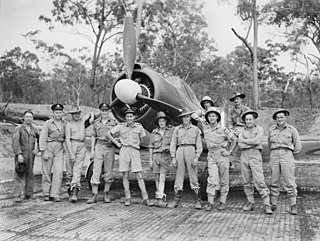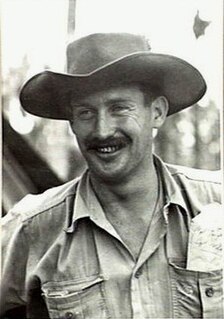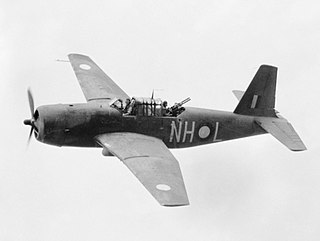
The North American B-25 Mitchell is a medium bomber that was introduced in 1941 and named in honor of Major General William "Billy" Mitchell, a pioneer of U.S. military aviation. Used by many Allied air forces, the B-25 served in every theater of World War II, and after the war ended, many remained in service, operating across four decades. Produced in numerous variants, nearly 10,000 B-25s were built. These included a few limited models such as the F-10 reconnaissance aircraft, the AT-24 crew trainers, and the United States Marine Corps' PBJ-1 patrol bomber.

No. 32 Squadron is a Royal Australian Air Force unit based at RAAF East Sale in Victoria. It currently flies training and transport operations. The squadron was raised in February 1942 for service during World War II. Equipped with Lockheed Hudsons, the squadron was tasked with anti-submarine, anti-shipping operations, bombing and reconnaissance missions in New Guinea. In late 1942, the squadron was withdrawn to Sydney and re-equipped with Bristol Beauforts, which it operated along the east coast of Australia until the war ended. The squadron was disbanded in November 1945, but was re-formed in 1989 and currently operates King Air 350s.

Mount Louisa is a residential suburb in the City of Townsville, Queensland, Australia. The suburb contains the mountain Mount Louisa. In the 2016 census, Mount Louisa had a population of 8,825 people.
No. 6 Squadron is a Royal Australian Air Force (RAAF) training and bomber squadron. It was formed in 1917 and served as a training unit based in England during World War I. The squadron was disbanded in 1919 but re-formed at the start of 1939. It subsequently saw combat as a light bomber and maritime patrol squadron during World War II, and took part in the New Guinea Campaign and New Britain Campaign before being disbanded after the war.

No. 11 Squadron is a Royal Australian Air Force (RAAF) maritime patrol squadron based at RAAF Base Edinburgh. It was formed in 1939 and has seen active service in World War II, East Timor, the War on Terrorism and the 2003 Gulf War. The squadron became known to the public through its participation in the Great Southern Ocean rescues of wrecked sailors, such as Tony Bullimore and Isabelle Autissier.

No. 16 Air Observation Post Flight was a Royal Australian Air Force (RAAF) unit that saw action in World War II supporting Australian Army operations. It was formed in October 1944 and disbanded in June 1947. The flight was reestablished in September 1958, and was disbanded again in December 1960, when its responsibilities were transferred to a joint Army-RAAF unit.

No. 38 Squadron was a Royal Australian Air Force (RAAF) transport and training unit active between 1943 and 2018. It was formed on 15 September 1943 and saw service during World War II transporting supplies and personnel between Australia and the combat zones in New Guinea and Borneo, using Douglas Dakota aircraft. Following the war, the squadron conducted regular courier flights between Australia and Japan in 1947 and 1948. No. 38 Squadron was deployed to Singapore from 1950 to 1952, supplying Commonwealth forces engaged in the Malayan Emergency and undertaking courier flights across Asia. In 1954 it became responsible for training RAAF personnel to operate Dakotas.

No. 83 Squadron was a Royal Australian Air Force (RAAF) fighter squadron of World War II. It was formed in 1943 as a 'home defence' squadron and provided air defence to several locations in Queensland, the Northern Territory and New South Wales before being disbanded in 1945.

No. 12 Squadron was a Royal Australian Air Force (RAAF) general purpose, bomber and transport squadron. The squadron was formed in 1939 and saw combat in the South West Pacific theatre of World War II. From 1941 to 1943, it mainly conducted maritime patrols off northern Australia. The squadron was based at Merauke in western New Guinea from November 1943 to July 1944, when it was withdrawn from operations. After being re-equipped, it operated as a heavy bomber unit from February 1945 until the end of the war. The squadron continued in this role until it was redesignated No. 1 Squadron RAAF in February 1948. The squadron was reformed in 1973 to operate transport helicopters but was again disbanded in 1989.

No. 100 Squadron was a Royal Australian Air Force (RAAF) bomber and maritime patrol squadron that operated during World War II. Raised in early 1942 from the remnants of a British unit that had been destroyed in Malaya, the squadron flew Bristol Beauforts from bases in Queensland and New Guinea, undertaking torpedo- and level-bombing sorties against Japanese targets in the Pacific theatre. Following the conclusion of hostilities, the squadron was disbanded in August 1946.

Herald Island is in Halifax Bay, south of the Great Palm Island group, northwest of Magnetic Island and northeast of Rollingstone, Queensland, in Australia. The nearest island is Rattlesnake Island. Other nearby islands are Cordelia Rocks, Bramble Island, and Acheron Island.
No. 23 Squadron of the Royal Australian Air Force (RAAF) is a non-flying base operations and training squadron headquartered at RAAF Base Amberley near Brisbane, Queensland. The squadron was formed in 1937 and saw action against the Japanese during World War II as a bomber squadron. Operating from Archerfield during the early stages of the war, the squadron undertook maritime patrols off Australia's east coast before converting to a dive-bomber role and taking part in the New Guinea campaign. Later in the war, the squadron converted to Liberator heavy bombers and flew missions against Japanese targets in the Netherlands East Indies. After the war, No. 23 Squadron was used to reform No. 6 Squadron and was then re-raised as a Citizens Air Force unit based in Brisbane. Until 1960, the squadron flew jet fighter aircraft before converting to a ground support role and now forms part of the RAAF's Combat Support Group.

No. 8 Squadron was an Australian flying training squadron of World War I and medium bomber squadron of World War II. The squadron was formed in England in October 1917 as part of the Australian Flying Corps, and disbanded in April 1919. It was re-formed by the Royal Australian Air Force in September 1939. After seeing action during the Pacific War flying Lockheed Hudson and, later, DAF Beaufort bombers, the squadron was disbanded a second time in January 1946.

No. 82 Squadron RAAF was a Royal Australian Air Force fighter squadron that operated during World War II and its immediate aftermath. It was formed in June 1943, flying Curtiss P-40 Kittyhawks and, initially, Bell P-39 Airacobras from bases in Queensland and New Guinea. The squadron became operational in September 1944, and undertook ground attack missions against Japanese targets in the Pacific theatre. Following the end of hostilities, No. 82 Squadron was re-equipped with North American P-51 Mustangs and deployed to Japan, where it formed part of the British Commonwealth Occupation Force. It remained there until October 1948, when it was disbanded.

No. 72 Wing was a Royal Australian Air Force (RAAF) wing that operated during World War II. It was formed in April 1943 at Townsville, Queensland, as part of North-Eastern Area Command. Led by Group Captain Charles Eaton, the wing soon deployed to Merauke, Dutch New Guinea, where it comprised three squadrons flying CAC Boomerang and P-40 Kittyhawk fighters, and A-31 Vengeance dive bombers. Eaton was succeeded by Group Captain Allan Walters in mid-1943. No. 72 Wing took part in the defence of Torres Strait, undertaking interception, patrol and occasional ground-attack and anti-shipping duties. By July 1944, its original squadrons had all been disbanded or transferred to other operational formations. No. 120 Squadron, which had arrived in May 1944, operating Kittyhawks, remained at Merauke until February 1945. The wing headquarters returned to Australia that May, and disbanded the following month.

Leslie Douglas (Les) Jackson, DFC & Bar was an Australian fighter ace of World War II, credited with five aerial victories. Born in Brisbane, he was a businessman when he joined the Royal Australian Air Force (RAAF) Reserve in 1937. Called up for active duty shortly after the outbreak of war in September 1939, he served with No. 23 Squadron in Australia before posting to the South West Pacific theatre with No. 21 Squadron in Singapore. In March 1942 he joined No. 75 Squadron in Port Moresby, New Guinea, flying P-40 Kittyhawks under the command of his eldest brother, John. During the ensuing Battle of Port Moresby, Les shot down four Japanese aircraft.
19e Transport Squadron, also known as No. 19 Squadron, was a transport and communications unit of the Militaire Luchtvaart van het Koninklijk Nederlands-Indisch Leger, formed in Australia during the final stages of World War II. The squadron was formed as a Dutch unit in late 1944 from two transport flights that had previously been based in Brisbane and Melbourne, and which had run supplies to joint Australian-NEI combat squadrons in the Northern Territory and in West Papua. Upon formation the squadron was based at Archerfield, near Brisbane. In 1945, it was transferred to the Royal Australian Air Force (RAAF), but returned to Dutch control in 1947 and subsequently took part in operations during the Indonesian National Revolution.

No. 75 Wing was a Royal Australian Air Force (RAAF) wing that operated during World War II. It was formed in October 1943 at Townsville, Queensland, under North-Eastern Area Command. The wing soon deployed to Horn Island to take control of RAAF units based there and at Thursday Island and Cape York Peninsula. Responsible for air defence and maritime patrol in the Torres Strait, No. 75 Wing's flying units operated P-40 Kittyhawk fighters, Bristol Beaufort reconnaissance bombers, and A-31 Vengeance dive bombers. The wing was disbanded in August 1944.

The Bore Sight Range and Compass Swinging Platform are a heritage-listed pair of aircraft testing facilities at Charters Towers Airport, Charters Towers, Charters Towers Region, Queensland, Australia. They were built from 1942 to 1943. They are also known as Charters Towers WWII Airfield Gun Firing Range and Compass Swinging Station. They were added to the Queensland Heritage Register on 14 May 2010.

The Royal Australian Air Force (RAAF) operated Vultee Vengeance dive bombers during World War II. The Australian Government ordered 297 of the type in late 1941 as part of efforts to expand the RAAF. This order was later increased to 400 aircraft. A few Vengeances arrived in Australia during 1942, and large-scale deliveries commenced in early 1943; further orders were cancelled in 1944 after 342 had been delivered.

















